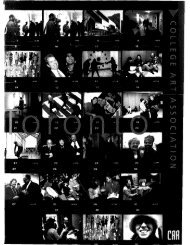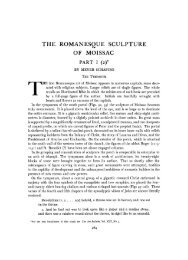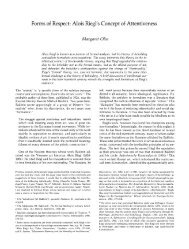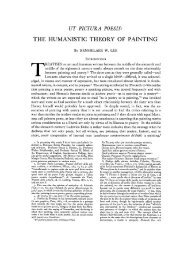Tragic Pompeii - College Art Association
Tragic Pompeii - College Art Association
Tragic Pompeii - College Art Association
You also want an ePaper? Increase the reach of your titles
YUMPU automatically turns print PDFs into web optimized ePapers that Google loves.
226 THE ART BULLETIN JUNE 1994 VOLUME LXXVI NUMBER 2<br />
the Lar, or "owl" of the ancestors. The domus interior thus<br />
invited certain kinds of memories, furnished anchoring<br />
points for them, and preserved them by holding them in<br />
place.4<br />
Elevated to metaphor and internalized as private memory<br />
loci, the Roman house offers insight into a formative mental<br />
model. As recent studies have suggested, viewing schemata<br />
not only were adopted metaphorically by Latin rhetoricians,<br />
but rhetorical theory influenced Roman perception.5 In<br />
learning the correct ways for "reading" the decorated house,<br />
educated Romans acquired certain attitudes toward the<br />
images it contained. The habit of disciplined recall and, most<br />
importantly, of association between the recalled parts was,<br />
above all, a creative activity. Cicero compared the making of<br />
memory images to painting a picture; the orator became a<br />
topographer of the imagination.6 It follows that the dynamic,<br />
reciprocal relationship between concrete image and verbalized<br />
meaning within the architectural mnemonic might<br />
operate in the pictorial programs of Roman houses as well.<br />
Seen in this way, memorza offers a new key to reading narrative<br />
ensembles: movement. Edwin Casey has argued that<br />
the body in motion plays a fundamental role in the process of<br />
remembering, for it "domesticates" space by attuning itself<br />
to the surroundings in order to "inhabit" and "feel at home"<br />
in past places. In maneuvering through the real or the<br />
imagined house, the viewer/orator selectively organizes the<br />
things around him. The body is not stationary, but a moving<br />
center in relation to which things constantly change position.<br />
I propose that the architectural mnemonic was a Roman<br />
modality requiring the active incorporation of a moving eye<br />
or body for the full comprehension of a visual narrative.7<br />
For a Roman, exploration of the private memory house<br />
naturally carried with it much of the collective memory<br />
outside. In ancient culture, memoria was one of the primary<br />
means of transmission from one generation to another, and<br />
the key example, the exemplum or paradigm, was the com-<br />
mon vehicle through which tradition was transmitted. The<br />
old-fashioned house and the inherited objects and legendary<br />
stories it contained connected age-old exempla in a new way.<br />
4 On the Roman house as an extension of a man's memory and the<br />
ancient references on damnatio memoriae, see J. Bodel, "Monumental<br />
Villas and Villa Monuments," in The Roman Vzlla: New Perspectzves, ed. A.<br />
Frazer, University of Pennsylvania Museum Press, forthcoming, and<br />
T. P. Wiseman, "Conspzcui postes tectaque digna deo: The Public Image of<br />
Aristocratic and Imperial Houses in the Late Republic and Early<br />
Empire," in L'Urbs: Espace urbain et hzstoire (ler szicle av.J. C.-III sticle ap.<br />
J. C. (Collection de l'Ecole Fran(aise de Rome, xcviil), 1987, 393-413. On<br />
the atrium as the locus for the display of ancestor busts: Pliny, Hzstoria<br />
naturalzs 35.2.6-7, trans. H. Rackham, Cambridge, Mass., 1952, 265.<br />
5Each with quite different results: R. Brilliant, Vzsual Narratives, Ithaca,<br />
N.Y., 1984, chap. 2; E. W. Leach, The Rhetorzc of Space: Literary and<br />
<strong>Art</strong>zstzc Representatzons of Landscape in Augustan Rome, Princeton, 1988;<br />
Rouveret, passzm.<br />
6<br />
Cicero, De oratore 2.87.357-358, trans. Sutton, 469-471. A. Rouveret,<br />
"Peinture et '<strong>Art</strong> de la memoire': Le Paysage et l'allegorie dans les<br />
tableaux grecs et romains," Comptes rendus des stances. Acadmzie des<br />
Inscrzptzons et Belles Lettres, 1982, 571-588.<br />
7 On "place-memory," see E.S. Casey, Rememberzng: A Phenomenologzcal<br />
Study, Bloomington, 1987, chap. 3. For a refutation of the ancient<br />
prejudice against mnemonic devices as a form of "unnatural learning,"<br />
see F. Bellezza, "Mnemonic Devices and Memory Schemas," in Imagery<br />
and Related Mnemonic Processes: Theorzes, Indzvidual Differences, and Applicatzons,<br />
ed. M. McDaniel and M. Pressley, New York, 1987, 34-55.<br />
For generations of scholars and visitors two thousand years<br />
removed, the Roman atrium-house has become an exemplum<br />
of Roman culture. As such, it is the site of a dialectic between<br />
historically remote periods and can act as a lens through<br />
which to perceive mechanisms of transmission. Scholarly<br />
investigation of the ancient interior is like a memory system<br />
in that we attach our ideas about Roman culture to its spaces<br />
and contents using the methods of labeling and matching.<br />
"Memory," then, encompasses an enormous range of meaning,<br />
from its broad synonyms of history, knowledge, and<br />
culture to the particular act or moment of recall and to the<br />
thing remembered. It can be a learned system (the architectural<br />
mnemonic), a person's natural faculty (in antiquity a<br />
sign of genius), an accidental flashback, a metaphor, or the<br />
collective guilt of a society (war crimes). The expansiveness<br />
of the concept opens up a field for the investigation of broad<br />
attitudes in, and about, the past and of our own assumptions<br />
and methodological tools in approaching it.8<br />
The very artificiality of the memory house as an access<br />
device to information invites a comparison of the mental<br />
model with the material evidence of a contemporary atriumhouse.<br />
The following paragraphs and images attempt to<br />
bring to mind a Roman place of the mid-first century A.D.,<br />
the House of the <strong>Tragic</strong> Poet in <strong>Pompeii</strong> (VI.8.3-5). Today<br />
the architectural shell is stripped nearly bare, with just a few<br />
fading frescoes and black and white mosaics (Figs. 1-3).<br />
Since its discovery, this small house has come to be regarded<br />
as a veritable paradigm of the Roman domus and has enjoyed<br />
a rich afterlife, furnishing a kind of stage set for the<br />
projection of our own retrospective notions about Roman life<br />
and manners. Of the over two hundred homes in <strong>Pompeii</strong><br />
deserving rescue, I pick this one because of its unique status<br />
and because of the modern delusion that we know it.<br />
The ongoing, simultaneous restoration and deconstruction<br />
of the fabric and contents of the House of the <strong>Tragic</strong><br />
Poet reveal a fascinating history of semiotic reception, and<br />
with it a great deal of irony. That an artifact so paradigmatic<br />
and so often displayed is also so much dismembered,<br />
neglected, and forgotten can tell us much about the selective<br />
workings of a modern collective memory. A close look at the<br />
remains shows that this "model house" is actually quite<br />
distinctive. The small atrium seems altogether too modest<br />
for the monumental figural panels simulated in fresco on its<br />
walls. To the nineteenth-century eye, the individual panels<br />
resembled the oil paintings one might see in a museum<br />
gallery, and in order to preserve them, a few years after their<br />
discovery they were cut out of their surrounding design and<br />
transported to an actual museum in Naples. With spoliation<br />
added to fantasy, today the house as a whole is in danger of<br />
entirely slipping from memory.<br />
My aim is to secure the future of the house by recontextualizing<br />
the panels and assessing their original appearance as<br />
an ensemble. To demonstrate the spatial relationships, I use<br />
an experimental scale model (Fig. 21), and then extend the<br />
recontextualization into a computer model that allows us to<br />
8 On these issues, see J. Le Goff, History and Memory, trans. S. Rendall<br />
and E. Claman, New York, 1992. The translation from the French<br />
reveals the different nuances of "memoire" as compared with the<br />
English "memory."










